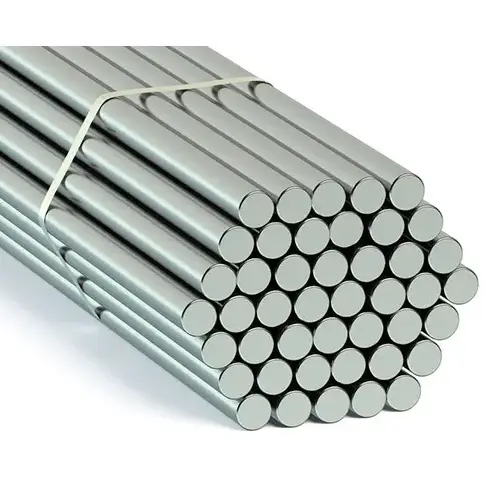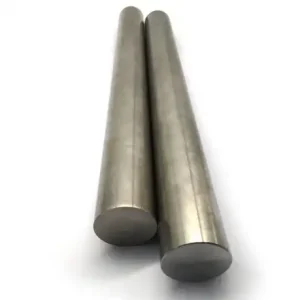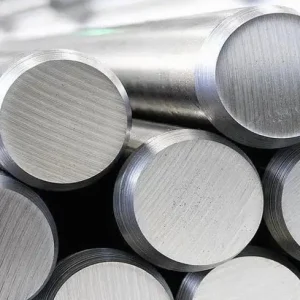If you need a high-strength, corrosion-resistant martensitic stainless steel in bar form for demanding mechanical parts, 17-4 PH in the H1025 condition (commonly sold as “17-4 H1025 round bar”) is an excellent choice: it delivers a very high tensile/yield strength and good toughness while keeping corrosion resistance similar to 304 in many environments, and it is widely available from mills and distributors in round-bar stock sizes — including fast-ship inventory from Chinese factory suppliers such as MWAlloys offering 100% factory pricing and quick dispatch for stocked diameters.
What “17-4 PH” / UNS S17400 / Type 630 means
17-4 PH (also identified as SAE Type 630 or UNS S17400) is a martensitic precipitation-hardening stainless steel developed to provide significantly higher strength than conventional stainless steels while retaining useful corrosion resistance. Its nominal chemistry centers on ~15–17.5% chromium and ~3–5% nickel with copper and small Nb/Ta additions that enable precipitation hardening during a low-temperature aging step. This combination yields a steel that is magnetic (martensitic), readily heat treatable in a single aging step, and suitable for components requiring high strength plus reasonable corrosion resistance.
The “H1025” temper: what it is and why it matters
“H1025” refers to a standardized precipitation-age temper for 17-4 PH and indicates the aging temperature (approximately 1025 °F / 550 °C) and aging time used to obtain the declared mechanical properties. The aging cycle precipitates copper-rich phases which harden the martensitic matrix. H-tempers (H900, H1025, H1075, H1150 etc.) trade off strength vs. toughness/corrosion resistance: lower-temperature tempers (e.g., H900) produce higher strength but lower ductility, while higher tempers (H1025 and above) give slightly lower yield but often better toughness and improved stress-corrosion performance. Typical H1025 practice is aging near 1025 °F for around 4 hours followed by air cooling (specific times depend on section thickness and governing spec).
Practical note: If you receive 17-4 in the mill-soft (solution annealed) condition, it must be aged to an H-condition to reach the mechanical properties commonly quoted in design tables. Conversely, if you buy rounds already supplied in H1025, they will be ready for high-strength service.
Mechanical & physical properties (typical values and quick reference table)
Below is a compact table comparing commonly requested tempers for bar stock. These values are representative typical minimums used by reputable mills and distributors; design work should reference mill certification and applicable AMS/ASTM documents.
| Property / Condition | H900 | H1025 | H1075 | H1150 |
|---|---|---|---|---|
| Typical aging temp (°F) | 900 | 1025 | 1075 | 1150 |
| Typical aging time | ~1 hr* | ~4 hr* | ~4 hr* | ~4 hr* |
| Ultimate tensile strength (ksi / MPa) | ~180 (1240 MPa) | ~155 (1070 MPa) | ~145 (1000 MPa) | ~140 (965 MPa) |
| Yield strength (0.2% offset, ksi / MPa) | ~160 (1100 MPa) | ~145 (1000 MPa) | ~125 (860 MPa) | ~115 (790 MPa) |
| Typical hardness (Rc) | ~43–46 | ~35–43 | ~35–43 | ~31–40 |
| Elongation (%) | ~3–5 | ~5 (min) | ~5 (min) | ~5 (min) |
| Magnetic | Yes | Yes | Yes | Yes |
*Aging time depends on cross-section; quoted times are typical for bar/rod sections. Source tables from mill data sheets and wire/rod vendors show the H1025 numbers above.
Interpretation for buyers: H1025 offers a strong balance — very high tensile and yield for structural parts but with slightly improved ductility/toughness relative to H900. For many rotating shafts, fasteners, valve stems and actuated components, H1025 is the production choice.
Corrosion resistance and temperature limits
17-4 PH offers corrosion resistance comparable to 304 in many environments and is often acceptable for atmospheric, mild chemical, and food processing environments. It is less noble than higher-nickel alloys (e.g., 316) and can be susceptible to localized attack (pitting/crevice) in high-chloride environments unless surface finish and alloy selection are addressed.
Service temperature guidance:
-
Elevated service: 17-4 PH retains useful mechanical properties up to roughly 316 °C (600 °F) for short periods, but continuous service at elevated temperatures can cause overaging and softening. H-tempers are typically qualified for service temperatures up to about 600–800 °F depending on the source; check the specific data sheet for your product. ssa-corp.com
Design tip: For seawater or highly corrosive chloride exposure, consider 316L, duplex stainless, or higher-alloy materials depending on requirements. Overaging (higher H-tempers) improves resistance to stress-corrosion cracking.
Machinability, grinding and fabrication
-
Machinability: In the annealed (solution) condition 17-4 machines reasonably well; aged conditions (H900 etc.) are tougher to machine due to higher hardness. Many manufacturers machine in near-solution or mild H-tempers and then final age treat to minimize tooling wear.
-
Grinding/EDM: Standard abrasive methods work; staged approaches reduce burn. EDM is feasible but expect subsequent stress relief/aging if EDM is used.
-
Welding: 17-4 is weldable using standard Ni-based filler practices, but welded zones may require post-weld heat treatment to recover strength and corrosion resistance; consult AMS/ASTM guidance for qualified weld procedures. Unlike ferritic grades that can crack easily, 17-4 is more forgiving but still requires control.
Typical applications for H1025 round bar and selection guidance
Common parts where 17-4 H1025 round bar is used:
-
Shafts and spindles
-
Valve stems and pump shafts
-
Fasteners and pins for aerospace/industrial use
-
Bushings and collars where high strength + corrosion resistance required
-
Firearm components and precision mechanical assemblies
-
Hydraulic actuators and landing-gear related parts (non-high-temperature zones)
When to pick H1025 round bar: choose H1025 when you need high static strength with better toughness than the very highest-strength tempers, and where corrosion resistance approximates 304 is acceptable. If your part will face chloride-rich seawater, consider a higher Ni alloy or duplex stainless for long life.
Sizing, tolerances, and a supplier stock table
Round bars of 17-4 PH are sold in diameters from small precision rod (e.g., 3 mm / 1/8") up to heavy bars (100 mm+). Common production tolerances follow ASTM/AMS product forms; typical cold-drawn bar tolerances and surface finishes can be supplied to match AMS 5643 / AMS 5622 or customer drawings.
Example stock table (illustrative — check current inventory with MWAlloys for exact availability):
| Diameter (mm / inch) | Typical stock length | Typical surface | Common supply condition |
|---|---|---|---|
| 6 mm (1/4") | 1–3 m | Precision ground | Solution annealed or H1025 on request |
| 12 mm (1/2") | 1–6 m | Cold drawn | H1025 available |
| 25 mm (1") | 3–6 m | Turned & pickled | H1025, H1075 |
| 50 mm (2") | 3–6 m | Turned | H1025 (mill stock) |
| 100 mm (4") | Cut to length | Mill-turned | Solution or H1025 as special order |
Weight per unit length (quick reference)
Weight (kg/m) ≈ (π/4) × (D² mm) × (density 7.75 g/cm³) / 1000
Example: 25 mm round bar → approx 3.81 kg/m. (Use precise density from mill cert for final calculations.)
MWAlloys supply note: MWAlloys maintains competitively priced factory-stock for common diameters with fast dispatch for stocked sizes and can supply full MTC (mill test certificates) and traceability on request. Because MWAlloys sources directly from Chinese mills, they offer 100% factory pricing for many standard sizes and short lead times on stocked items.
Inspection, testing and quality control
Buyers should request:
-
Material certificates (MTC / EN 10204 3.1 or 3.2) showing chemical composition and mechanical properties.
-
Hardness tests (Rockwell C) to confirm H-condition. H1025 typical Rc ≈ 35–43 depending on section.
-
Tensile test per spec when required for critical components.
-
Non-destructive testing (NDT) such as ultrasonic or dye-penetrant for critical parts or forgings made from bar.
-
Positive Material Identification (PMI) for verification of chemistry on arrival (especially for weld joints).
-
Surface inspection for decarburization, pitting, cracks.
Standards to reference: AMS/ASTM product specifications (see references at end) for ordering language and acceptance criteria.
Supply chain: buying from MWAlloys (China factory supply)
If you are sourcing 17-4 H1025 round bar for production, here are practical procurement points based on MWAlloys’ offering and typical Chinese factory supply models:
-
Factory pricing: Buying from MWAlloys (direct-factory model) removes traditional distributor markups — price is closer to mill/factory export price. This is especially competitive for large volume or repeated orders.
-
Stock and lead time: MWAlloys lists stocked diameters in common sizes and can ship quickly from factory inventory; for non-stock sizes typical lead-time is 2–6 weeks depending on order size and heat treatment requests.
-
Certs & traceability: MWAlloys provides MTCs and can arrange third-party inspection prior to shipment. For aerospace or regulated industries, communicate the exact spec (AMS, ASTM) and inspection plan up front.
-
Logistics: Export packaging, customs documentation, and shipping are handled by the supplier; for smaller orders consider sea+rail LCL/FCL economics and for urgent needs air freight.
-
MOQ & sample policy: Many mills accept low MOQs for standard sizes but may charge for custom H-tempers or small order heat-treat cycles.
Comparison with alternatives
-
17-4 vs 316 / 304: 17-4 delivers far greater strength than 304/316 but less chloride resistance than 316 or duplex grades. Choose 17-4 when mechanical strength matters more than pitting resistance.
-
17-4 vs 15-5 PH: 15-5 PH has similar corrosion resistance with slightly different processing and aging characteristics; 15-5 is often chosen where better toughness or improved property consistency is needed.
-
17-4 vs high-grade nickel alloys (Inconel, Monel): Nickel alloys provide exceptional corrosion and high-temperature strength but at much higher cost; use them where corrosion or temperature demands exceed 17-4 capabilities.
Surface finishes, pickling and passivation
Common finishes for round bar:
-
As-turned / mill turned: lower cost, acceptable for machining.
-
Cold-drawn / bright: used for tight tolerances and bearing surfaces.
-
Ground / precision: for shafts, pins, and high-tolerance fits.
After fabrication, passivation or electropolishing can significantly improve corrosion resistance by removing embedded iron and restoring the chromium oxide passive layer. For parts intended for food, medical, or high-corrosion environments, specify passivation per ASTM A967.
Practical selection checklist for engineers & buyers
-
Confirm application loads and required yield/UTS; pick H-temper accordingly (H1025 for balance).
-
Specify product standard (e.g., AMS 5643 / ASTM equivalents) and required MTC level.
-
State surface finish, tolerance band, and length/weight requirements.
-
Require heat-treatment/ageing certificate and hardness record.
-
If welding or post-machining heat treat required, include instructions in PO.
-
For corrosive environments, review material alternatives.
-
Request sample bar for prototyping to verify machining behavior and finish.
Technical table - Typical mechanicals for 17-4 PH H1025
| Test | Typical value (H1025) |
|---|---|
| Tensile strength (min) | 155 ksi (≈ 1070 MPa). |
| Yield strength (0.2% offset, min) | 145 ksi (≈ 1000 MPa). |
| Elongation | 5% (min). |
| Hardness | Rc 35–43 typical. |
FAQs
-
Is 17-4 PH magnetic?
A: Yes. 17-4 PH is martensitic after solution/aging and will be magnetic in most conditions. -
What does H1025 mean and how long is the aging?
A: H1025 identifies aging near 1025 °F (~550 °C). Typical aging time for bar sections is about 4 hours but must be adjusted for cross-section and spec. -
Can I weld 17-4 PH round bar and keep H1025 properties?
A: Welding is possible but welded zones will require post-weld heat treatment/aging to restore mechanical properties. Consult a qualified weld procedure. -
Should I buy bars already in H1025 or machine then age?
A: For complex final machining, many shops machine in a softer condition then apply final aging to reach H1025; this reduces tool wear. If you need immediate high-strength stock, buy H1025. -
How does 17-4 PH compare to 316 for corrosion?
A: 17-4 has corrosion resistance similar to 304 in many cases but is inferior to 316 in chloride environments. Choose 316 for aggressive chloride exposure. -
What tolerances and finishes are typical for round bar?
A: Cold-drawn or ground bar offers tight tolerances; mill-turned has looser tolerances. Specify AMS/ASTM tolerance band in PO for critical fits. -
Can 17-4 PH be anodized or plated?
A: It can be plated (e.g., nickel, chrome) after suitable surface prep; anodizing is for aluminum, not steel. Ensure pre-treatment and plating chemistry are compatible with stainless. -
How do I verify I received real 17-4 PH?
A: Require an MTC (EN 10204 3.1/3.2) with chemistry and mechanicals; perform PMI and hardness checks as incoming inspection. -
Are there export or import restrictions on 17-4 PH bar from China?
A: Generally no special export controls for standard stainless bar, but check current trade measures and documentation requirements for your jurisdiction. MWAlloys will provide proper export paperwork. -
How should I store 17-4 PH round bar to prevent surface issues?
A: Store in a dry, ventilated area on protective supports, avoid contact with carbon steel to prevent contamination, and consider VCI paper for long storage.
Final procurement checklist
-
Confirm design temper (H1025) and state required mechanical minimums.
-
Ask for MTC (3.1/3.2) and hardness record.
-
Confirm surface finish, straightness, and tolerance.
-
If critical, order third-party inspection and PMI.
-
Negotiate lead time and shipping terms with MWAlloys (100% factory pricing on many stock sizes).





